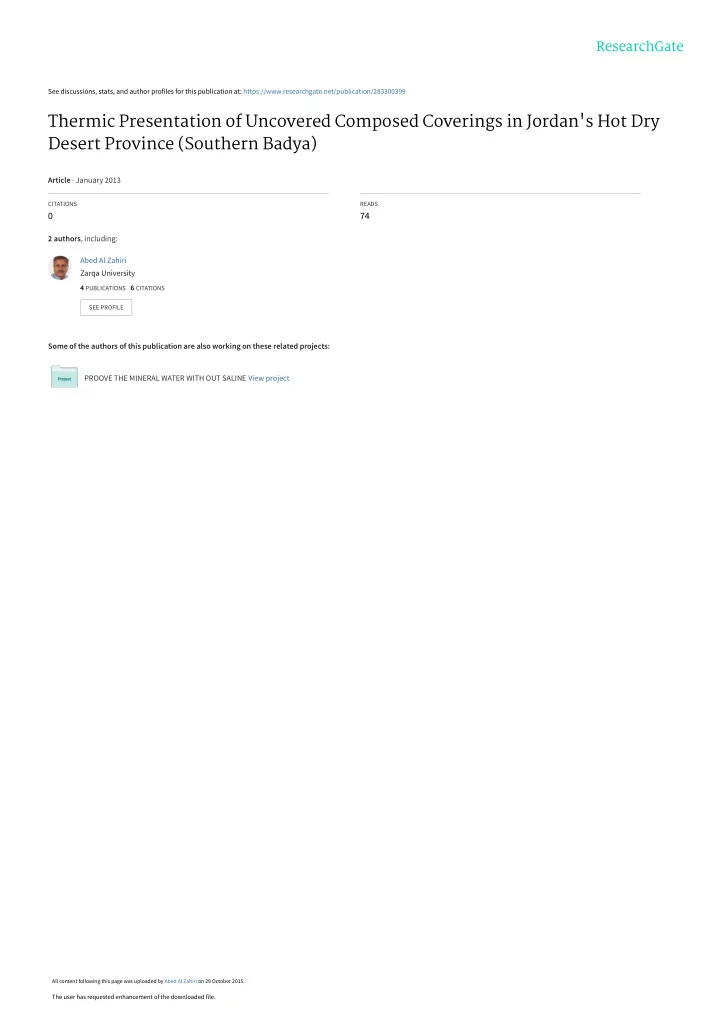

See discussions, stats, and author profiles for this publication at: https://www.researchgate.net/publication/283300399 Thermic Presentation of Uncovered Composed Coverings in Jordan's Hot Dry Desert Province (Southern Badya) Article · January 2013 CITATIONS READS 0 74 2 authors , including: Abed Al Zahiri Zarqa University 4 PUBLICATIONS 6 CITATIONS SEE PROFILE Some of the authors of this publication are also working on these related projects: PROOVE THE MINERAL WATER WITH OUT SALINE View project All content following this page was uploaded by Abed Al Zahiri on 29 October 2015. The user has requested enhancement of the downloaded file.
Journal of Environment and Earth Science www.iiste.org ISSN 2224-3216 (Paper) ISSN 2225-0948 (Online) Vol. 3, No.1, 2013 Thermic Presentation of Uncovered Composed Coverings in Jordan's Hot Dry Desert Province (Southern Badya) Abed Al-Zahiri and Mohammad Al-Rawashdeh Civil Engineering Department, Zarqa University, tel:+962-5-3821100, fax: +962-5-3821120, P.O.Box: 132222, Zarqa, Jordan *E-mail of the corresponding author: dr_abed_alzahiri@yahoo.com Abstract Thermic performance for any building in hot dry province depend on the external climatic factor, the ability of the construction materials used in gained heat through day time and loss this heat through night time through the nocturnal radiation. Covering is considered the major part of the building envelop which exposed to high thermic load due to the high solar intensity and high outside air temperature through summer which reach to 6 months. In Jordan the thermic effect of covering is increased as one go towards from north to south. This study evaluate the thermic performance of different test rooms with different coverings construction; non-insulated concrete, insulated concrete, double, plant, and active concrete coverings, built under the effect of external climatic condition of very hot and dry province in Jordan (Southern Badya province). The external climatic conditions and the temperature distribution inside the covering construction and the interior air temperature were measured. The results of this study recognized that the thermic transmittance (UValue) has a major role in choosing the built materials. Also the thermic insulation considered the suitable manner for damping the thermic stresses among day time and makes the interior environment of the building near the console zone during most months of the a whole year. Natural night and forced ventilation are more important in improving the internal conditions. The construction covering systems show that the interior air temperature thermic damping reach to 96%, 90%, 89%, and 76% for insulated concrete, double, planted and non-insulated concrete coverings. The results also investigate the importance of using the ground as a cooling source through the active concrete system. Keywords: Thermic insulation, covering, double covering, green covering, shaded covering, building envelope, and thermic console. 1. Introduction Southern Badya province is a desert province located in the south east of Jordanian. This province is very hot and dry province; it is about 500-1100 m above sea level. In such climate human console is crucial to provide the reasonable environment for people in this new community and save energy. The thermic response of building is defined as the reaction of the building envelope to some form of heat input and amount of internal loads. It depends mainly on the orientation, size, windows to wall ratio, also on the thermo-physical and optical properties of the building material, and on the external environmental conditions. A building envelope is defined as the separation between the interior and the exterior environments of a building. It serves as the outer shell to protect the interior environment as well as to facilitate its climate control. Building envelope design is a specialized area of architectural and engineering practice that draws from all areas of building science and interior climate control. Building envelope design includes four major performance objectives; structural integrity, moisture control, temperature control, and control of air pressure boundaries of sorts, control of air includes air movement through the components of the building envelope (interstitial) itself, as well as into and out of the interior space, which affects building insulation greatly. The physical components of the envelope include the foundation, covering, walls, doors and windows. The dimensions, performance and compatibility of materials, fabrication process and details, their connections and interactions are the main factors that determine the effectiveness and durability of the building enclosure system. Common measures of the effectiveness of a building envelope include physical protection from weather and climate (console), interior air quality (cleanliness and public health), durability and energy efficiency. In order to achieve these objectives, all building enclosure systems must include a solid structure, a drainage plane, an air barrier, a thermic barrier, and may include a vapor barrier( Building envelopes , 2003). 29
Recommend
More recommend